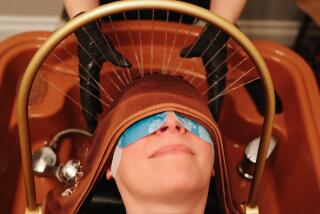Some athletes like it cold — real cold
- Share via
A cream-colored Spanish villa on a street near Hancock Park lined with cottonwood trees houses the medical office where a steady stream of pro and amateur athletes comes looking to chill out.
And by chill, we mean standing nearly naked for a few minutes in a 6-foot-tall metal chamber as blasts of nitrogen chill the air inside to nearly minus-300 degrees Fahrenheit.
Such bone-chilling conditions might sound harmful, but the whole-body cryotherapy treatment utilizes extreme cold in small doses to speed muscle recovery and reduce inflammation after workouts or surgery.
The theory is that the cold tricks the body into believing it’s freezing so it enters a self-preservation state, sending blood to its core to protect vital organs. There, it is enriched with oxygen, nutrients and enzymes. After the treatment, the super-rich blood rushes back to the extremities, where it’s said to flush out toxins and improve circulation.
Among athletes, it’s considered a Space Age alternative to the conventional ice bath.
“It’s really legit,” said Texas Rangers All-Star pitcher C.J. Wilson, who began undergoing ice sauna treatments in August and said he tries to complete at least one between his scheduled starts.
Players from the Dallas Mavericks, San Antonio Spurs and Pittsburgh Steelers have used the treatment, as have the Lakers’ Kobe Bryant and world-class sprinter Tyson Gay.
Nike bought a machine for its Beaverton, Ore., campus and is investigating cryotherapy’s effects.
“We’re convinced that it works and that it helps,” said former marathon star Alberto Salazar, head coach of Nike’s Oregon Project, which trains distance runners. “We’re trying to figure out the optimal way to use it.”
Cryohealthcare, which opened in February 2010, is the only clinic in Los Angeles with a “cryosauna.” Its clientele includes the Hollywood elite and pro athletes, including Bryant, according to Aleksandr Matorin, managing director of Millennium ICE, a Dallas-based company that sells the machines.
Bryant couldn’t be reached for comment.
In June, during Bryant’s visit to a German soccer club’s rehabilitation center, the Lakers star used its on-site cryosauna and said on the soccer club’s website, “It’s an incredibly intense feeling.”
Dr. Jonas Kuehne, who attended UCLA’s David Geffen School of Medicine, runs Cryohealthcare. At his clinic, ice sauna treatment costs about $70 a session. Each session lasts about 2½ minutes.
Patients wear gloves and socks to prevent frostbite, and only the head is exposed outside the chamber. After the treatment, patients warm up within minutes and feel an energy boost and enjoy quicker recovery time from fatigue and injuries, Kuehne said.
This treatment was developed in Japan in the late 1970s. It later took root in Europe and has been used by pro soccer players. The therapy didn’t reach the U.S. until 2008, Matorin said.
Even then, whole-body cryotherapy didn’t gain much notoriety until this year, when several Dallas Mavericks — including Dirk Nowitzki, Jason Kidd, Jason Terry and Shawn Marion — used it during their NBA championship run. “It gives you a youthfulness,” Terry told a Dallas TV station, “and if you have any aches and pains, instantly when you step out of that chamber, you’re revived.”
After Dallas won the title, Matorin said his company experienced an explosion of interest. He said that by the end of October, 19 offices in the U.S. would have cryosaunas.
Sports performance coach Tom Shaw said that during the NFL lockout about 40 players, including several Pittsburgh Steelers, trained at his camp at the Disney Resort’s Wide World of Sports complex in Florida and used his $50,000 cryosauna on a daily basis.
“This thing ain’t going to make anybody faster or more explosive, but it’s going to help them recover. That’s the key,” Shaw said.
In comparison with a conventional ice bath, cryotherapy is also less uncomfortable.
“I hate the ice bath. Absolutely hate it. It’s the worst thing in the world,” Wilson said. “I surf, so I’m used to cold water, but there’s just something about sitting in that thing I always hated. But this thing, it’s cool, and you’re dry so you feel OK after three or four minutes.”
Nevertheless, the cold is a jolt.
“When you get in it, it’s similar to if you went outside on the coldest day of the year, completely naked,” Salazar said. “It’s a little scary at first because you’ve never felt so cold, but in reality it only goes in a millimeter or two [into the skin], so there’s no danger.”
Salazar said Nike officials are studying the therapy’s effectiveness. Although they have found no side effects, they believe it may not be as useful if it’s used daily for a month.
Matorin’s company has a domestic competitor in US Cryotherapy, which sells larger chambers that treat four people at once. Although its temperatures don’t reach as low as a cryosauna, said Kevin Kramer, US Cryotherapy’s chief operating officer, it has the same effect as the rival device. Kramer’s company has distribution rights in North America for the chamber, which is manufactured by a German firm.
Still, ice sauna treatments are riding a growing wave of popularity.
Kuehne initially had only a casual interest in sports medicine. But the ice sauna treatments are well-known in his native Germany, and when the device reached the U.S. a few years ago he was intrigued.
His L.A. client list has grown so fast that he wants to open an additional clinic in Malibu.
“I never meant to think of this as a business. This was more of a side thing,” Kuehne said. “But it really has grown.”
baxter.holmes@latimes.com twitter.com/baxterholmes
More to Read
Go beyond the scoreboard
Get the latest on L.A.'s teams in the daily Sports Report newsletter.
You may occasionally receive promotional content from the Los Angeles Times.










